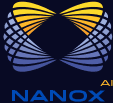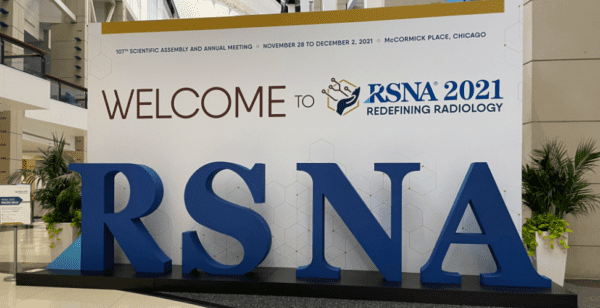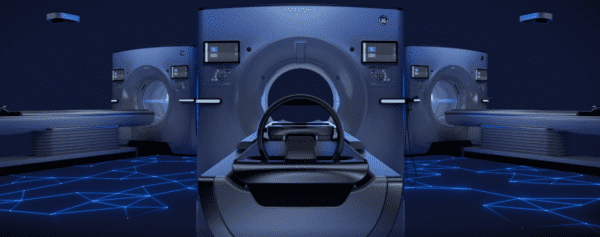|
RSNA 2021 Reflections
December 6, 2021
|
|
|

|
|
Together with
|

|
|
|
“I wouldn’t want my mom treated at a hospital where doctors are burned out.”
|
|
Saurabh Jha, MD’s RSNA debate response to the age-old question whether he’d be OK with expanding mid-level responsibilities if his mother needed care.
|
|
|
We’re excited to share the latest Imaging Wire Show, featuring Novarad’s Paul Shumway. Join us for a great conversation about how new technologies are helping imaging providers safely and securely improve patient engagement.
|
|

|
|
The first in-person RSNA since COVID is officially a wrap. Hope you had a blast if you made it to Chicago and a productive week if you stayed home. We also hope you enjoy The Imaging Wire’s big takeaways from what might have been both the most special and most subdued RSNA ever.
Crowds & Conversations – We were already expecting 50% lower attendance than RSNA 2019, but the exhibit hall and cab lines looked more like 70% below 2019’s crowds (even less on Sunday & Wednesday). That said, most of the stronger companies had steady booth traffic and nearly every exhibitor emphasized that the attendees who did show up were ready to have high-quality conversations.
Focus on Productivity – Just about every product message at RSNA focused on productivity and efficiency, often with greater emphasis than clinical effectiveness. The modality-based efficiency enhancements seemed to be the most impactful, which is good news for technologist bandwidth and patient throughput, but might be bad news for rad burnout unless informatics/AI efficiency can catch up (it doesn’t seem like that happened this year).
Modality Milestones – The major OEMs did a good job making modalities cool again, debuting milestone innovations across both their MR (low-helium, low-field, reconstruction, coils) and CT (photon-counting, spectral, upgradability) lineups. We also saw the latest scanners take big strides in operator efficiency and patient experience. There weren’t many breakthroughs with X-ray or ultrasound, and most point-of-care ultrasound OEMs stayed home (rads aren’t their market anyway), but attendees seemed okay with that.
AI Showcase – The RSNA AI Showcase had solid traffic and high energy (especially on Mon & Tues), helped by continued AI buzz and the fact that RSNA finally let AI vendors out of the basement. The AI Showcase highlighted many of the trends we’ve been seeing all year, including larger vendors transitioning to AI platform strategies, an increased focus on workflow integration and care coordination, and a greater emphasis on radiologist efficiency. There were also far fewer brand-new AI tools than previous years, as many vendors focused on improving their current products and/or expanding their portfolio via partnerships.
PACS Cloud Focus – PACS vendors continued to place a major emphasis on their respective cloud advantages, and there was a widespread consensus that cloud is on every imaging IT roadmap. The PACS vendors seemed to talk less about multi-ology enterprise imaging than previous years, and expanding EI beyond radiology/cardiology still seemed pretty futuristic for most players. It was also quite clear that most of the PACS players’ AI marketplaces/platforms haven’t been as prioritized as earlier announcements might have suggested.
Best RSNA Since… 2019 – We’ve heard some folks saying this was the “best RSNA ever” because it was easy to get around and it was great to see everyone, but those seem more like pandemic silver linings than “best ever” qualifications. Still, the imaging industry made the most of RSNA 2021, and everyone seemed truly happy to be together again after two long years of working from home. As long as COVID cooperates, we should be set up for an excellent RSNA 2022.
|




|
|

|
|
GE Healthcare had another busy RSNA, highlighted by several major modality launches and an overarching focus on helping imaging teams be more productive.
Return to MR Hardware – After focusing on AIR Recon DL during the last two RSNAs, GE Healthcare’s MR team made sure to roll-out new hardware at this year’s show.
- GE’s MR section was headlined by its new SIGNA Hero 3T MR, which brings a wide range of improvements (image quality, workflows, productivity, comfort, reconstruction, helium & energy), and a major focus on operator efficiency.
- GE also unveiled the SIGNA Artist Evo, which allows health systems / imaging centers to upgrade their existing 1.5T 60cm-bore MRs with 70cm bore systems (w/ AIR Recon DL & AIR Coils), without the construction and downtime typically required when upgrading to a net new MR system.
GE’s Scalable CT Platform – GE unveiled the unique Revolution Apex platform, which offers the modularity and scalability to cover a wide range of current and future needs, and represents GE’s biggest CT launch since 2014.
- The FDA-cleared Revolution Apex CT is available with multiple detector coverage configurations (40mm, 80mm, 160mm, upgradable w/o replacing gantry) and is offered with GE’s new Smart Subscription service (allows software upgrades/downgrades, plus auto updates).
- True to GE’s productivity focus, the Revolution Apex also includes a range of features to improve technologist efficiency and/or expand clinical applications (e.g. “Effortless Workflow,” patient positioning camera, TrueFidelity DLIR, motion correction for cardiac).
Much More – GE Healthcare has been busy throughout 2021, so although the other products in its RSNA booth were still quite new, they’ve already been detailed in previous Imaging Wire issues. Some of these other highlights include its in-development Photon Counting CT, it’s now FDA-approved Endotracheal Tube X-ray AI tool, its StarGuide SPECT/CT scanner, and its recent alliance with Optellum.
|




|
|
Pivoting to Population Health AI
Check out this Imaging Wire Show, featuring Nanox AI strategy leader, Dr. Orit Wimpfheimer, where we discuss building an international telerad practice, what’s wrong with triage AI, and pivoting to population health AI.
|
|

|
|
At a time when many major AI companies are trying to become AI platform companies, Arterys announced a trio of 3rd party AI alliances that showed how a mature AI platform might work.
Arterys Expands Neuro AI – Arterys launched neuroradiology AI alliances with Combinostics and Cercare Medical, expanding Arterys’ already-comprehensive Neuro AI suite (also includes MRI brain tumor diagnostics, CT stroke & ICH detection, 2D/4D Flow brain MRI). Combinostics’ cNeuro cMRI supports multiple neurological disorder assessments (specifically dementia and multiple sclerosis), while Cercare Perfusion automates brain CT and MRI perfusion map generation and stoke treatment decision making.
Arterys Adds Breast AI – Arterys launched a global distribution agreement with iCAD, making iCAD’s full suite of breast health solutions available in Arterys’ new Breast AI suite. iCAD’s portfolio is certainly broad enough to deserve its own “suite,” ranging from 2D and 3D mammography detection, personalized risk screening and decision support, and density assessments. The Arterys Breast AI suite also makes iCAD available as a cloud-based SaaS solution for the first time (previously only on-premise).
Arterys Platform Impact – Arterys’ integration of multiple complementary AI tools within curated AI Suites is unique and makes a lot of sense. It seems to be far more helpful to provide neurorads with integrated access to a suite of neuro AI tools, than to provide them with one or two tools for every subspecialty.
The Takeaway – Arterys’ new alliances reveal a far more subspecialist-targeted approach than we usually see from AI platforms or marketplaces. It also shows that Arterys is committed to its vendor neutral strategy, effectively doubling its number of active AI partners (previously: Imaging Biometrics & Avicenna.AI in Neuro suite, MILVUE in Chest MSK Suite), while highlighting the value of its cloud-native structure for integrating new partners within the same user interface.
|




|
|
Why X-Ray Will Remain a Mainstay Modality
There might be more “advanced” imaging modalities, but X-ray keeps growing and will be a mainstay modality for the foreseeable future. See the factors driving X-ray’s growth in this GE Healthcare report.
|
|
- TCH’s Auto-Assignment Effect: After noticing that its neuroradiology workload wasn’t being evenly distributed (some rads not reading enough, some prioritizing easier studies), Texas Children’s Hospital adopted an automated neuroradiology assignment tool that evened-out workloads and improved turnaround times (TAT) for stat studies. Their RSNA presentation showed that automatically assigning non-stat MR and CTs to individual rads during daytime/weekday shifts, while leaving stat studies unassigned, reduced wRVU/radiologist disparities (hourly range decreased by 18%) and stat study TATs (83min to 59min), without affecting non-stat TATs (142min vs. 144min).
- Subtle & Bayer’s MR Enhancement Collaboration: Subtle Medical and Bayer launched a research collaboration that will explore how SubtleGAD could improve contrast-enhanced MRI exams, and potentially lead to new areas for contrast media use. This alliance might strike some as counterintuitive, but it’s pretty logical given their shared clinical goal (diagnostic efficiency/accuracy), overlapping expertise (enhancement), and the possibility that DLIR and contrast enhancement could prove to be better together.
- COVID’s Brain MRI Volume Impact: A new Emory study found that early COVID lockdowns might have reduced brain MRI volumes, but its ratio of severe cases increased. Emory’s brain MRI volumes dropped by 17% between March-August 2019 and 2020 (6,745 vs. 5,601), while its share of high-acuity brain MRIs increased (Level 3: 34% to 40%). Even after brain MRI volumes rebounded in September-December 2020, Emory’s ratio of high-acuity findings remained far higher than the same period in 2019 (Level 3: 42.6% vs. 34.1%).
- Harrison.ai’s $97M: Australian AI startup Harrison.ai completed a massive $97M Series B round (total now ~$121M) that it will use to support its expansion into new regions and new healthcare areas. Harrison.ai’s healthcare expansion strategy will rely on a joint venture with major pathology/radiology provider Sonic Healthcare, that will focus on developing and commercializing pathology AI solutions. If this sounds familiar, Harrison.ai similarly created Annalise.ai through a JV with I-MED Radiology.
- Big AI Valuations: Speaking of major AI funding rounds, CBInsights reports that private healthcare AI companies raised $8.5B through the first three quarters of 2021, surpassing 2020’s full-year total of $6.6B. Most of that funding didn’t go to imaging AI companies, but several imaging AI companies are included among 2021’s leaders for fundraising value (Exo & Infervision) and venture investment activity (Philips).
- Blackford & 3M Integrate: Blackford announced a new alliance with 3M Health Information Systems that will integrate 3M M*Modal Fluency for Imaging into Blackford’s imaging AI platform in North America. This alliance seems to make a lot of sense given Blackford and 3M’s shared goal of improving reporting workflows, the upside of their respective installed bases, and the fact that their key competitor offers both speech and an AI marketplace.
- Stroke Scout CTs: A Mayo Clinic stroke team developed a new workflow to rapidly screen wake-up stroke patients to confirm if they can safely undergo the MRI exams that are required to support thrombolytic therapy decisions. The team added full-body CT scout imaging to their acute stroke CT head protocol, allowing them to identify metallic implants that aren’t safe for MRI exams, and quickly scan MRI-safe patients.
- Novarad’s Screening Partnerships: Novarad announced a trio of screening-focused partnerships at RSNA. Novarad expanded its breast cancer screening capabilities, announcing partnerships to integrate CureMetrix (mammography AI detection) and Ikonopedia (breast reporting and tracking) into its NovaMG PRO mammography platform. Novarad also enhanced its lung cancer screening capabilities, expanding its partnership with PenRad to offer PenLung (lung nodule tracking & reporting) and PenAlert (incidental tracking & reporting) with its NovaPACS enterprise imaging suite.
- Commercial Radiology Premiums: A new Johns Hopkins and Michigan State study found that US hospitals charge commercial insurers up to six-times more than Medicare rates for radiology services, while revealing major variations between different hospitals. Analysis of 13 shoppable radiology services at 2k hospitals found median commercial premiums ranging from 2.2x for mammography ($289 commercial vs. $129 Medicare) to 5.9x for non-contrast head/brain CT ($813 vs. $137). Hospitals’ negotiated commercial rates in the 10th and 90th percentile could also be extremely different, most notably with brain MRI before and after contrast ($965 & $3,033) and contrast-enhanced abdominal CT ($791 & $3,024).
|
|
- This year, as part of their Software Upgrades for Life commitment, United Imaging upgraded its entire U.S. MR installed base with the latest major releases, including 12 new applications, Windows 10, and its United Compressed Sensing (uCS 2.0) platform.
- Trying to figure out how your IT resources can handle increased AI adoption? This Blackford paper details how the cloud is helping radiology organizations scale their computing resources to support multiple AI applications or algorithms.
- See how Einstein Healthcare Network reduced its syringe expenses, enhanced its syringe loading, and improved its contrast documentation when it upgraded to Bayer Radiology’s MEDRAD Stellant FLEX CT Injection System.
- This European Radiology study highlighted Riverain Technologies’ ClearRead Xray – Detect as one of just two imaging AI products to achieve the FDA’s most stringent premarket approval level. See how they measured up against the other 99 AI tools here.
- CD burning issues? Check out this one-minute video showing how Novarad’s CryptoChart image sharing solution allows patients to easily access and share their medical images using personalized, highly secure QR codes (not CDs).
- This Arterys white paper details how cloud-based AI tools have become essential for streamlining and improving lung nodule detection and tracking.
|
|
|
|
|